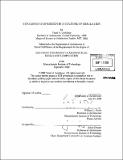Conceptions of design in a culture of simulation
Author(s)
Loukissas, Yanni, 1976-
DownloadFull printable version (41.78Mb)
Other Contributors
Massachusetts Institute of Technology. Dept. of Architecture.
Advisor
William L. Porter.
Terms of use
Metadata
Show full item recordAbstract
Design is a system of relationships in flux. Practitioners at Arup, a global design consultancy, negotiate a place for themselves within this system by using simulations to mediate their professional relationships. Simulations are spaces of exchange; they bridge between the technical domains of practitioners at Arup and the particular needs of their clients. Over the past sixty years, Arup has expanded into new domains of work by creating simulations to suit new audiences: architects, regulators, curators, developers, and insurers. For practitioners at Arup, simulations are pliable media for exploration, communication and professional positioning. My study of simulation at Arup builds on a history of scholarship by writers like Lewis Mumford, Sherry Turkle, and Peter Galison, who examine how cultures define themselves through the technologies they use and the way they use them. My contribution to this discourse is to show how designers use simulations to establish the professional relationships and the conceptual distinctions that define their work. Through selected scenarios from the project history of Arup, this dissertation describes how simulations are used, not only to describe designs, but to construct conceptual distinctions, between the prescriptive knowledge of regulators and the performance-based knowledge of simulations; between the intent of form envisioned by architects, and its performance, articulated by engineers at Arup; and between the identity of the scientist and that of the designer, both strategically embraced by practitioners at Arup. (cont.) These conceptual juxtapositions and others underlie efforts by practitioners at Arup to make a place for themselves in design. My dissertation concludes with a reflection on an implicit metaphor in use at Arup, that simulation is a kind of theatre. By probing this metaphor, we can understand the* practice of simulation as a balance between immersive and analytical ways of engaging audiences. Creating a valid simulation at Arup, like creating a successful theatrical performance, is all about connecting with your audience in the right way.
Description
Thesis (Ph. D.)--Massachusetts Institute of Technology, Dept. of Architecture, 2008. Includes bibliographical references (p. 196-201).
Date issued
2008Department
Massachusetts Institute of Technology. Department of ArchitecturePublisher
Massachusetts Institute of Technology
Keywords
Architecture.